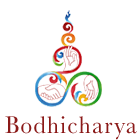The Treasury of Knowledge Book 8 Meditation Parts 2 and 3

This extensive series of Summer 2002 Kagyu Samye Ling teachings on Jamgön Kongtrül Lodro Thaye’s Treasury of Knowledge follows directly on from the previous year’s recordings.
Jamgön Kongtrül divides his Chapter 8 on Meditation into 4 sections:
- The First Section discusses Shamatha (calm abiding) and Vipassana (insight meditation) -as taught the previous year in 2001: https://bodhicharya.org/teachings/archives/the-treasury-of-knowledge-book-8-meditation
- The Second Section concerns the meditation techniques of the Sutrayana;
- The Third Section concerns Vajryana meditation based on Tantras; and
- The Fourth Section concerns Vajryana meditation based on the direct Oral Traditions.
These recordings encompass both The Second Section: the Meditation Techniques of the Sutrayana (“Meditation in the Cause-Based Dialectical Approach”) and The Third Section (“The Elements of Tantric Practice” )
For any students or practitioners using Richard Barron’s English translation: “Foundations of Buddhist Study and Practice”,
https://www.shambhala.com/authors/g-n/jamgon-kongtrul-lodro-taye/the-treasury-of-knowledge-book-seven-and-book-eight-parts-one-and-two-2407.html
1. The Second Section of Chapter 8 starts at page 260. At 07:37 Rinpoche commences with a discussion of the distinctions between the Vinaya, Abidharma and Sutra; whereas these meditation teachings are those of the whole Sutrayana. At 11:10 the source verse is stated and teaching starts. All subsequent recordings 1. to 12. follow Jamgön Kongtrül’s text with Ringu Tulku elucidating in detail on the meditation techniques of the Sutrayana.
Questions and Answers
Q. 51:28 You seem to be saying that renunciation is the foundation of meditation and spiritual practice, but that it’s difficult. Is it a particulary difficult notion in the West? There doesn’t seem to be much interest in renunciation amongst Dharma Practitioners!
Q. 57:57 If you make Enlightenment your goal, will the rest of the Path (such as dealing with desire) take care of itself?
Q. 01:02:05 I wanted to ask about the Enlightenment stage of consciousness: has it always been there within us; or is it going to develop?
Q. 1:04:11 If the mind, in its truest form, is enlightened, what can’t it be like that already; from when we are born?
Q. 1:06:21 Rinpoche, can I ask about reducing attachment to place? Isn’t renunciation to do with your state of mind, as much as physically being in the town or the monastery?
Q. 1:10:00 Do you think that attachments are based on our biological circumstances?
2. Questions and Answers
Q. 28:35 Last year, you said that the way we react to things in our dreams gives an indication of how we’ll react to things in the bardo. Is there any way in which we can transform the way we react to things in our dreams, if we are not advanced practitioners?
Q. 30:31 Could you say something about causation? Is it that every event is the result of an event before? Is experience a chain of causation? Or does it allow for new directions as a result of creativity?
Q. 36:12 I was wondering if time works in a non-linear way; where a cause in the future, can affect the past or present?
Q. 40:00 Can we affect the past and present, by the ways in which we remember them? If, one day, I think I had an unhappy childhood; and another, a happy childhood; does that have subsequent consequences?
Q. 40:50. Is time itself relative, or is it our experience that is relative? If there were no sentient beings to experience it, or be aware of change; would change still happen?
Q. 46:08 Is there still a succession of past, present and future moments? Where every moment follows the next?
Q. 46:37 Are you saying that if time doesn’t exist; then the “past, present and future” don’t really exist? Are they dependent upon us conceptualising them, or do they exist anyway?
3. Questions and Answers
Q. 48:59 Are constructs of our mind when we put things together and give them a name?
4. The 37 aspects of Enlightenment are discussed.
Rinpoche continues with the text over the six next sessions with multiple opportunities for student questions until:
10. This teaching commences the final section of the English Translation volume “Foundations of Buddhist Study and Practice”: the Actual Stages of Meditation (p283 in the text) in 3 sections: 1. General Stages of Mind Training (p284) 2. Formal Meditation and Postmeditation practice (p286) 3. The Four Yogas or Applications (a Summary p288)
13. For any students or practitioners using the English translation of the 8th Meditation Chapter’s Third Section; translated into English as:“The Elements of Tantric Practice” by Ingrid Loken McLeod and Elio Guarisco commences with this recording, where Vajryana meditation based on Tantras is discussed.
https://www.shambhala.com/the-treasury-of-knowledge-book-eight-part-three-2406.html
For more information, visit: https://bodhicharya.org/teachings/archives/the-treasury-of-knowledge-book-8-meditation



